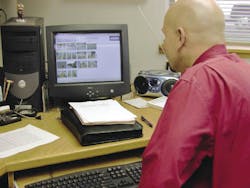Integrating Access Control with Video
Dealers, integrators and resellers aren’t just talking about integrating access control with video—they are doing it.
Card transactions, associated video and badging photos need to be viewed simultaneously, eliminating the need to access multiple systems or flip to alternate screens. Software applications can include integrated digital video management, visitor management and alarm monitoring. Hardware offerings can include standalone computer-managed locks as well as networked hardwired and wireless devices so that the customer has the right solution for every different type of environment.
Finding the solutions
To assure compatibility, the system must operate in multiple server environments, including Windows NT, 2000, 2003 and XP, and be OBDC and MDAC compliant. Its controllers need to provide multiple communications options and make decisions at the local level in case communication with the host is lost. All industry standard credential technologies must be supported as well as an unlimited number of card holders and devices. The system must also provide a seamless migration path so that end-users can upgrade their system as their security requirements expand, while being able to leave their existing databases and hardware intact.
There are multiple criteria when looking at the video side as well. The system should be able to associate video with both online and offline lock transactions and provide video Web-based remote capabilities. Video events should be searchable by various criteria including day, time, camera and alarm type, while providing instant access to stored video. Captured video must be able to be sent in various formats using mobile phones, PDAs and/or PCs to alert security personnel quickly.
Mobile video in vehicles should be compatible with various networks including cellular, wireless and mesh or LAN/WAN and provide simultaneous video recording and playback on all channels. The system should provide remote PTZ camera control and event driven recording, including pre- and post-alarm and video motion detection.
In the Richland (Calif.) School District, which includes three high schools, three middle schools and nine elementary schools, authorized individuals who enter a building outside of school hours must use a proximity card to unlock the door, then enter a security code inside the building within 60 seconds to disable an alarm. At the same time, the event gets recorded via digital video.
According to John Steach, executive director of Support Services, changing times and the need for proactive security led to the search for a long-term security solution that would grow with the District’s needs. For years, people in the community were allowed to use the school facilities for activities such as after-hours basketball games. Thus, many residents had keys to the buildings but with increasing theft and vandalism, it became necessary to improve key control. A proprietary key system was used as a first step, followed by magnetic stripe card access.
“Even though we distributed the cards district-wide, the system was not centrally programmable and did not give us the flexibility to manage community use. We still needed a custodian to lock and unlock the doors after hours,” Steach said.
The District selected the Schlage Security Management System, an integrated solution that eliminates the need to support and maintain multiple systems and also provides the flexibility to manage both networked and standalone openings.
In addition to proximity card readers at exterior doors and intrusion alarm keypads inside, the system incorporates glass breakage detectors at all ground-floor windows. In areas with student records or high-value items such as computers are kept, motion detectors are also installed. As a final measure of protection, all critical areas are monitored by digital video cameras to provide a record of any questionable incidents.
So how does the system tie together during an incident? Steach said he received a call from a staff member on a Saturday evening, stating that his car had been broken into. Among the items stolen was his identification badge, which also serves as the proximity card needed for building access.
“From my laptop at home, I checked a past history report to verify that the badge hadn’t been used, checked the status of the school, pulled the cameras up to be sure nobody was in the school and deactivated the badge,” related Steach. “I took care of all this from home in about five minutes.”
Steach added that, had the badge been used from the time it was stolen until he deactivated it, he could have checked the video to see if the person was still there and notified the police to go to the school at once.
The access control system world is not one of black or white. There are many shades of gray. A new generation of electronic locks, video systems and security management software offers many options for you to design custom applications for your customers and keep them moving forward with flexibile, scalable technology.
Gary D’Aries, Ingersoll Rand Security Technologies, is the vice president, Schlage Software and Controllers.
